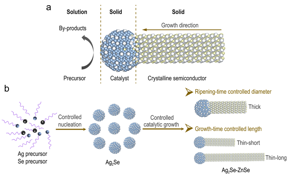Home > Press > USTC found a pathway to high-quality ZnSe quantum wires
 |
| (a) The solution-solid-solid growth mechanism. (b) Two-step catalyzed growth for independent radial and axial size control of ZnSe QWs.
CREDIT ©Science China Press |
Abstract:
One-dimensional semiconductor nanowires with strong quantum confinement effect, i.e. quantum wires (QWs), are of great interest for applications in advanced optoelectronics and photochemical conversions. Beyond the state-of-the-art Cd-containing ones, ZnSe QWs, as a representative heavy-metal-free semiconductor, have shown the utmost potential for next-generation environmental-friendly applications.
USTC found a pathway to high-quality ZnSe quantum wires
Beijing, China | Posted on April 8th, 2022
Unfortunately, ZnSe nanowires produced yet are largely limited to the strong quantum confinement regime with near-violet-light absorption or to the bulk regime with undiscernible exciton features. Simultaneous, on-demand, and high-precision manipulations on their radial and axial sizes that allows strong quantum confinement in the blue-light region has so far been challenging, which substantially impedes their further applications.
In a new article published in the National Science Review, a research team led by professor YU Shuhong at University of Science and Technology of China (USTC) has reported the on-demand synthesis of high-quality, blue-light-active ZnSe QWs by developing a flexible synthetic approach a two-step catalytic growth strategy that enables independent, high-precision, and wide-range controls over the diameter and length of ZnSe QWs. In this way, they bridge the gap between prior magic-sized ZnSe QWs and bulk-like ZnSe nanowires.
The researchers found that a new epitaxial orientation between the cubic-phase catalyst tips and wurtzite ZnSe QWs kinetically favors the formation of ultrathin, stacking-fault free QWs. The strong quantum confinement, high-degree size control, and the absence of mixed phases together lead to their well-defined, ultranarrow excitonic absorption in the blue-light region with full width at half maximum (FWHM) of sub-13 nm. After surface thiol passivation, they further eliminated the surface electron traps in these ZnSe QWs, resulting in long-lived charge carriers and high-efficiency solar-to-H2 conversion.
The two-step catalyzed growth strategy is believed to be general for a variety of colloidal nanowires. The access to those high-quality nanowires would thus offer a versatile material library for heavy-metal free applications in solar fuels and optoelectronics in the future.
####
For more information, please click here
Contacts:
Bei Yan
Science China Press
Office: 86-10-64015905
Expert Contact
Shu-Hong Yu
University of Science and Technology of China
Copyright © Science China Press
If you have a comment, please Contact us.
Issuers of news releases, not 7th Wave, Inc. or Nanotechnology Now, are solely responsible for the accuracy of the content.
News and information
![]()
Nanomedicine for brain cancer April 8th, 2022
![]()
Interdisciplinary team studies challenges and prospects of lithium-CO2 dioxide batteries April 8th, 2022
Possible Futures
![]()
Nanomedicine for brain cancer April 8th, 2022
Chip Technology
![]()
First integrated laser on lithium niobate chip: Research paves the way for high-powered telecommunication systems April 8th, 2022
![]()
Graphene gets enhanced by flashing: Rice process customizes one-, two- or three-element doping for applications March 31st, 2022
Optical computing/Photonic computing
![]()
First integrated laser on lithium niobate chip: Research paves the way for high-powered telecommunication systems April 8th, 2022
![]()
Graphene gets enhanced by flashing: Rice process customizes one-, two- or three-element doping for applications March 31st, 2022
![]()
Peering into precise ultrafast dynamics in matter March 25th, 2022
![]()
Artificial neurons go quantum with photonic circuits: Quantum memristor as missing link between artificial intelligence and quantum computing March 25th, 2022
Discoveries
![]()
Three dimensional Mn-doped NixSy/Ni2P and Mn-doped Ni2O3/Ni2P nanosheets as efficient electrocatalysts for alkaline overall water splitting April 8th, 2022
![]()
Interdisciplinary team studies challenges and prospects of lithium-CO2 dioxide batteries April 8th, 2022
Announcements
![]()
Three dimensional Mn-doped NixSy/Ni2P and Mn-doped Ni2O3/Ni2P nanosheets as efficient electrocatalysts for alkaline overall water splitting April 8th, 2022
![]()
First integrated laser on lithium niobate chip: Research paves the way for high-powered telecommunication systems April 8th, 2022
![]()
Interdisciplinary team studies challenges and prospects of lithium-CO2 dioxide batteries April 8th, 2022
Interviews/Book Reviews/Essays/Reports/Podcasts/Journals/White papers/Posters
![]()
Three dimensional Mn-doped NixSy/Ni2P and Mn-doped Ni2O3/Ni2P nanosheets as efficient electrocatalysts for alkaline overall water splitting April 8th, 2022
![]()
First integrated laser on lithium niobate chip: Research paves the way for high-powered telecommunication systems April 8th, 2022
![]()
Interdisciplinary team studies challenges and prospects of lithium-CO2 dioxide batteries April 8th, 2022
Energy
![]()
Three dimensional Mn-doped NixSy/Ni2P and Mn-doped Ni2O3/Ni2P nanosheets as efficient electrocatalysts for alkaline overall water splitting April 8th, 2022
![]()
Scavenger nanoparticles could make fuel cell-powered vehicles a reality April 1st, 2022
![]()
Workhorse of photovoltaics combined with perovskite in tandem for the first time February 25th, 2022
Photonics/Optics/Lasers
![]()
First integrated laser on lithium niobate chip: Research paves the way for high-powered telecommunication systems April 8th, 2022
![]()
Graphene gets enhanced by flashing: Rice process customizes one-, two- or three-element doping for applications March 31st, 2022
![]()
Peering into precise ultrafast dynamics in matter March 25th, 2022
![]()
Artificial neurons go quantum with photonic circuits: Quantum memristor as missing link between artificial intelligence and quantum computing March 25th, 2022
Solar/Photovoltaic
![]()
Graphene crystals grow better under copper cover April 1st, 2022
![]()
Peering into precise ultrafast dynamics in matter March 25th, 2022
![]()
Workhorse of photovoltaics combined with perovskite in tandem for the first time February 25th, 2022
![]()
Scientists enhance energy storage capacity of graphene supercapacitors via solar heating January 28th, 2022










